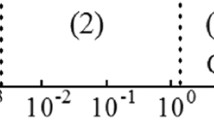Abstract
The present paper presents a theory for the mechanics of cross-talk among constituent neurons in networks in which multiple memory traces have been embedded, and develops criteria for memory capacity based on the disruptive influences of this cross-talk. The theory is based on interconnection patterns defined by the sequential configuration model of dynamic firing patterns. The theory accurately predicts the memory capacities observed in computer simulated nets, and predicts that cortical-like modules should be able to store up to about 300–900 selectively retrievable memory traces before disruption by cross-talk is likely. It also predicts that the cortex may has designed itself for modules of 30,000 neurons to at least in part to optimize memory capacity.
Similar content being viewed by others
References
Abeles M (1982) Local cortical circuits. Springer, Berlin Heidelberg New York
Aertsen A, Palm G (eds) (1986) Brain theory. Springer, New York Berlin Heidelberg
Amari S-I (1989) Characteristics of sparsely encoded associative memory. Neural Networks 2:451–457
Braitenberg V (1977) On the texture of brains. Springer, New York Berlin Heidelberg
Braitenberg V (1978) Cell assemblies in the cerebral cortex. In: Heim R, Palm G (eds) Theoretical approaches to complex systems. Springer, New York Berlin Heidelberg, p 171
Eccles JC (1981) The modular operation of the cerebral neocortex considered as the material basis of mental events. Neuroscience 6:1839–1856
Gerstein GL, Bedenbaugh P, Aertsen A (1989) Neuronal assemblies. IEEE Trans BME 36:4–14
Hopfield JJ (1982) Neural networks and physical systems with emergent collective computational abilities. Proc Natl Acad Sci 79:2554–2558
Kohonen T (1972) Correlation matrix memories. IEEE Trans Com-put C-21:353–359
MacGregor RJ (1987) Neural and brain modeling. Academic Press, New York
MacGregor RJ (1991a) The sequential configuration model for firing patterns in local neural networks. Biol Cybern 65:339–349
MacGregor RJ (1991b) Theoretical mechanics of neural networks. Academic Press, New York (in preparation)
McEliece RJ (1987) The capacity of the Hopfield associative memory. IEEE Trans Inf Theory IT-33:461–482
Palm G (1980) On associative memory. Biol Cybern 36:19–31
Palm G (1981a) On the storage capacity of an associative memory with randomly distributed storage elements. Biol Cybern 39:125–127
Palm G (1981b) On the storage capacity of an associative memory with randomly distributed storage elements. Biol Cybern 39:125–127
Palm G (1981c) Towards a theroy of cell assemblies. Biol Cybern 39:125–127
Palm G (1982) Rules for synaptic changes and their relevance for the storage of information in the brain. In: Trappl R (eds) Cybernetics and systems research. Elsevier, Amsterdam
Palm G (1987a) On the asymptotic information storage capacity of neural networks M.P.I, for Biol Cybern, Comnsci Book
Palm G (1987b) Local rules for synaptic modification in neural networks. M.P.I. for Biol Cybern, Comnsci Book
Sejnowski TJ (1986) Open questions about computation in cerebral cortex. In: McClelland JL, Rumelhart DE (eds) Parallel dis-tributedc processing: explorations in the microstructure of cognition, vol. 2: Applications. MIT Press, Cambridge
Sztengaothai J (1983) The modular architectonic principle of neural centers. Rev Physiol Biochem Pharmacol 98:11–61
Vaadia E, Bergmann H, Abeles M (1989) Neuronal activities related to higher brain functions — theoretical and experimental implications. IEEE Trans BME 36:25–35
Author information
Authors and Affiliations
Rights and permissions
About this article
Cite this article
MacGregor, R.J., Gerstein, G.L. Cross-talk theory of memory capacity in neural networks. Biol. Cybern. 65, 351–355 (1991). https://doi.org/10.1007/BF00216968
Received:
Accepted:
Issue Date:
DOI: https://doi.org/10.1007/BF00216968




